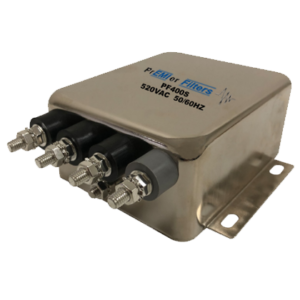Three-phase EMI (Electromagnetic Interference) filters are electronic devices used to suppress electromagnetic interference in three-phase electrical systems. They are commonly employed in industrial and commercial applications where electrical equipment can generate or be susceptible to EMI. These filters help ensure the proper functioning of sensitive electronic equipment and maintain compliance with electromagnetic compatibility (EMC) standards.
COMMERCIAL/INDUSTRIAL THREE PHASE EMI POWER LINE FILTERS
Premier Filters Inc., Commercial/Industrial Three Phase EMI Power Line Filters are specified for voltages to 520VAC and currents to 100A.
Please contact us at +1(657)226-0091 or at info@premieremc.com to discuss your project and filtering needs.
For different termination styles (E.G. QD, Connector, etc.) and Y-Cap values, consult Factory.
Here are some key features and aspects of three-phase EMI filters to review them, please continue to scroll below the products section:
COMMERCIAL/INDUSTRIAL
POWER LINE FILTERS
3PH / 0-520VAC
DELTA CONFIGURATION
STUD TERMINALS
MECH DIM
99x84x45 (MM)
MECH DIM
102x76x70 (MM)
MECH DIM
152x102x70 (MM)
MECH DIM
203x89x70 (MM)
MECH DIM
254x102x83 (MM)
COMMERCIAL/INDUSTRIAL
POWER LINE FILTERS
3PH / 0-520VAC
WYE CONFIGURATION
STUD TERMINALS
MECH DIM
99x84x45 (MM)
MECH DIM
108x76x70 (MM)
MECH DIM
127x102x70 (MM)
MECH DIM
178x102x83 (MM)
- Three-Phase Power: Three-phase EMI filters are designed for three-phase power systems, which are commonly used in industrial settings for powering motors, machinery, and other equipment.
- EMI Suppression: The primary function of these filters is to suppress electromagnetic interference generated by the connected equipment and to prevent external interference from affecting the operation of the connected devices. This is achieved by filtering out unwanted high-frequency noise and harmonics.
- Filter Types: Three-phase EMI filters come in various types, including common-mode and differential-mode filters. Common-mode filters target noise that appears in phase with all three phases, while differential-mode filters address noise that appears between individual phases.
- Frequency Range: The filters are designed to operate within specific frequency ranges, typically from a few kHz to several MHz, depending on the application’s requirements.
- Component Design: Three-phase EMI filters typically consist of passive components such as capacitors, inductors, and sometimes ferrite beads. These components are carefully selected and arranged in a way that attenuates unwanted electromagnetic noise while allowing the desired power frequency (usually 50 or 60 Hz) to pass through with minimal impedance.
- Compliance: EMI filters are designed to meet various international EMC standards and regulations, such as IEC 60939, to ensure that the connected equipment complies with electromagnetic compatibility requirements.
- Mounting Options: These filters can be mounted on a DIN rail or directly on the equipment’s enclosure, depending on the application and space constraints.
- Rated Current: Three-phase EMI filters are available in various current ratings to match the current requirements of the connected equipment.
- Applications: They are commonly used in motor drives, variable frequency drives (VFDs), power supplies, welding equipment, UPS (Uninterruptible Power Supply) systems, and any other industrial or commercial equipment that may generate or be sensitive to electromagnetic interference.
- Installation: Proper installation and grounding of three-phase EMI filters are essential to ensure their effectiveness. Care must be taken to follow the manufacturer’s recommendations for installation and maintenance.

